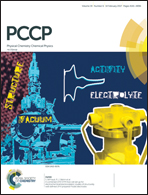Low intensity, continuous wave photodoping of ZnO quantum dots – photon energy and particle size effects†
Abstract
The unique properties of semiconductor quantum dots (QDs) have found application in the conversion of solar to chemical energy. How the relative rates of the redox processes that control QD photon efficiencies depend on the particle radius (r) and photon energy (Eλ), however, is not fully understood. Here, we address these issues and report the quantum yields (Φs) of interfacial charge transfer and electron doping in ZnO QDs capped with ethylene glycol (EG) as a function of r and Eλ in the presence and absence of methyl viologen (MV2+) as an electron acceptor, respectively. We found that Φs for the oxidation of EG are independent of Eλ and photon fluence (φλ), but markedly increase with r. The independence of Φs on φλ ensures that QDs are never populated by more than one electron–hole pair, thereby excluding Auger-type terminations. We show that these findings are consistent with the operation of an interfacial redox process that involves thermalized carriers in the Marcus inverted region. In the absence of MV2+, QDs accumulate electrons up to limiting volumetric densities ρe,∞ that depend sigmoidally on excess photon energy E* = Eλ − EBG(r), where EBG(r) is the r-dependent bandgap energy. The maximum electron densities: ρev,∞ ∼ 4 × 1020 cm−3, are reached at E* > 0.5 eV, independent of the particle radius.



 Please wait while we load your content...
Please wait while we load your content...